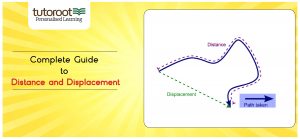Complete Guide to Distance and Displacement
Distance and Displacement are two important parameters in Physics, that help students understand various complex topics and chapters easily. So, it is essential for the students to have a good understanding about define Distance and Displacement meaning, their formulas, relation, as well as differences. Therefore, to help them out, we have put together a detailed guide to Distance and Displacement below.

What is Distance?
Distance is defined as the total length of the path covered by an object, when it moves from one point to another, regardless of the direction. The Distance is stated as a scalar quantity, and is represented by “S”.
In mathematical form,
Δd = d1 +d2
What is Displacement?
Unlike distance, Displacement is described as the change in the position of the object. Moreover, it is considered as a vector quantity, as it has both magnitude and direction. Besides, the displacement directly depends on the length of the path the object has taken, while moving from the initial and final position.
In mathematical form,
\(Δx = x_{f} – x_{o}\)
Δx = Displacement
xf = Final Position
x0 = Initial Position
For example, if a person has gone to a shop to buy a certain product, and after buying the product he returned to his/her home. Then the total displacement, in this case, is zero, as the starting and ending point is the same.
Differences Between Distance and Displacement
Now that you have understood the quantities, distance, and displacement in detail. Let us discuss the various distance and displacement differences.
| Parameter | Distance | Displacement |
| Definition | The length of the path traveled by the object from one point to another. | The shortest distance covered by the object, while traveling from the initial to the final position. |
| Type of Quantity | Scalar Quantity | Vector Quantity |
| Magnitude | It cannot be negative | It can be either positive or negative |
| Formula | Δd=d1+d2
|
Δx=xf−x0
|
| Unit | Meter(m) | Meter(m) |
| Time | It does not decrease with respect to time | It can either decrease or increase with respect to time |
Relation between Displacement and Distance
Mathematically, the relation between distance and displacement is defined as,
d>s,
Where d = distance
s = displacement
For instance, the distance is the total length of the path covered by the object, while the displacement is the shortest distance between initial and final positions.
However, for linear forms, the distance can be stated as equal to the displacement, which is explained by the equation,
d=s
Final Notes
In the above, we have provided a comprehensive description of the distance and displacement, and also distinguish between distance and displacement. And you can find many other complex topics and chapters in Physics that are not very easy to understand. So, it is better for students to join online coaching classes to improve their knowledge of the subject. If you are interested, then you can check out the cost-effective online interactive classes offered by the Tutoroot platform, as they offer various features.
Frequently Asked Questions
Write Any Two Differences Between Distance and Displacement?
There are many differences between Distance and Displacement, such as the d is a scalar quantity, while s is a vector quantity. And the magnitude of distance should remain positive, while the displacement’s magnitude varies from positive to negative.
What are Distance and Displacement?
Distance is stated as the length of the path traveled by an object from one point to another. Displacement is the shortest distance between the initial position and the final position.
